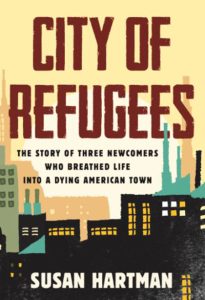New book tells how refugees saved a dying American town
A new book tells the inspirational story of three refugees who helped to rescue the dying rust-bucket town of Utica in upstate New York.
In the mid-1800s, Utica, NY had a larger population than Detroit, Cleveland or Chicago.
 The size of the town reached 100,000 in the 1930s but then began decline that saw it drop to 60,000 in 2000.
The size of the town reached 100,000 in the 1930s but then began decline that saw it drop to 60,000 in 2000.
The town turned corner after that, revitilising its city centre largely thanks to the presence of refugees.
Many of the refugees who settled in Utica came from war-torn homelands such as Vietnam, Burma, Bosnia-Herzegovina, Somalia or Iraq.
In her new book, ‘City of Refugees: The Story of Three Newcomers Who Breathed Life Into a Dying American Town’, author Susan Hartman depicts the crucial role migrants can play in local economies while also depicting their innate humanity.
“Most Americans haven’t had contact personally with refugees,” Ms Hartman said in a recent video interview.
“They feel worried and see them as people who will be a drain on the economy, with huge families on public assistance. I hope this book dispels the myths and puts a human face on the refugees, showing the reality of how hard they work,” she said.
Ms Hartman began writing about Utica and its refugees in 2013, first publishing a story in the New York Times.
During her research, she met he subjects of what would become her book: Sadia, a rebellious teenage girl in a Somali family headed by a single mother; Ali, an Iraqi who had worked for the US during the war; and Merisha, who fled the Bosnian conflict in the in the 1990s.
“This was very much an accidental book. These three people just hooked me. I was riveted by their stories and had no idea what was going to happen. I was always waiting for the next trip,” Ms Hartman said.
 Over seven years the author got to know the three families intimately while writing about how their challenges and accomplishments were emblematic of the way their town was coming back to life.
Over seven years the author got to know the three families intimately while writing about how their challenges and accomplishments were emblematic of the way their town was coming back to life.
She said she did not set out to write political book but hers became one when President Trump attacked migrants and ended the US’ refugee program.
“It might make the book feel more political, because… you become aware the city was on an upswing and beginning to thrive because of the refugees, but when the pipeline was cut, the city suffered,” Ms Hartman said.
“Now, they are excited in Utica about welcoming more refugees,” Hartman says. “The companies and factories and the resort need them, and there is a hospital going up too.”
Ms Hartman said the toxic political debate over migration was not a focus for the refugees themselves.
“They are not as upset as you might think; they are focused on work and surviving. The refugees who were already here felt secure; they were Americans or on their way to becoming Americans and didn’t feel personally threatened. And the older people were not getting news from American sources but were focused on getting news from their home country,” she said.
Ms Hartman’s reporting over eight years gives insights into how the families carry on with their lives.
There are triumphs and setbacks in each of their lives and they each adapt to changing circumstances.
And there is a sense that whatever happens, success is a matter of perspective.
“When just about anything happens, these refugees can say, ‘I’ve been through worse’. Their resilience is enormous,” Ms Hartman says.
‘City of refugees: The story of three newcomers who breathed life into a dying America town’. By Susan Hartman. Published by Beacon. $33.54












